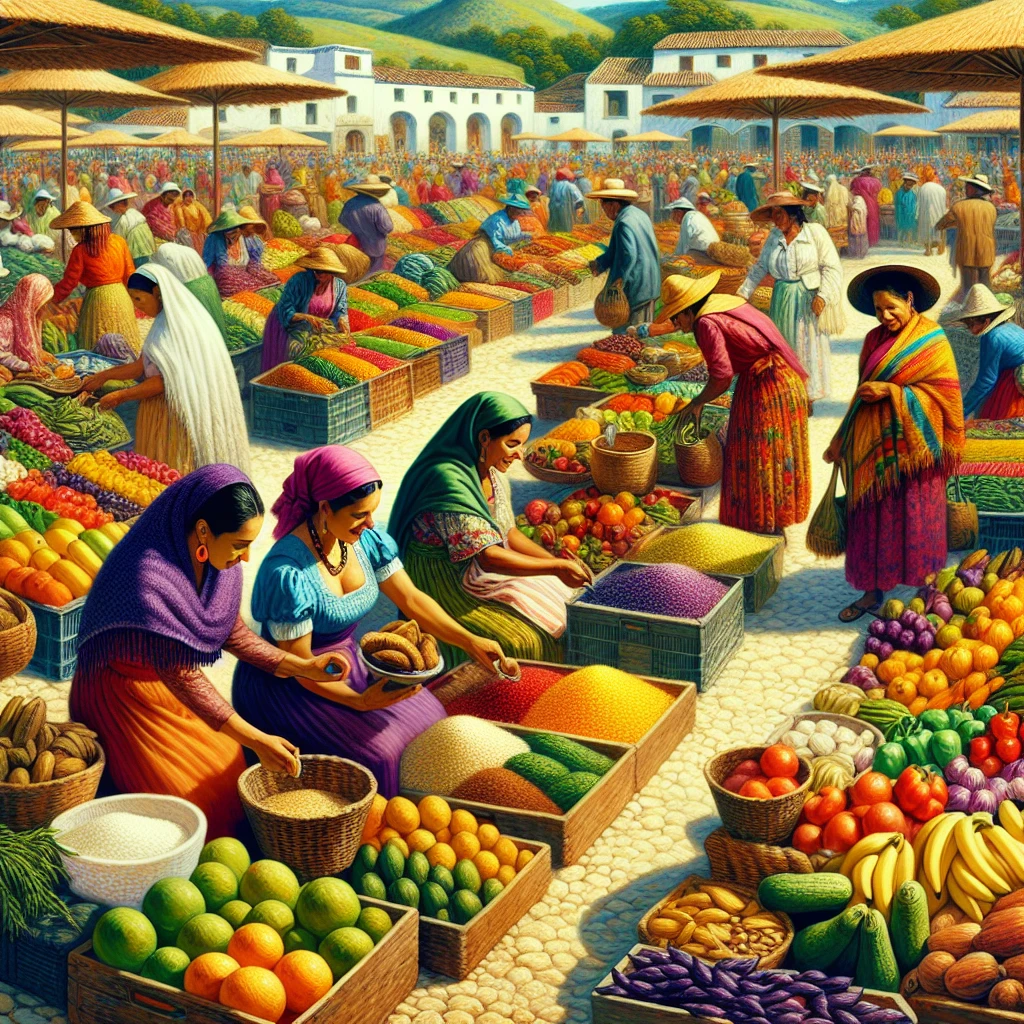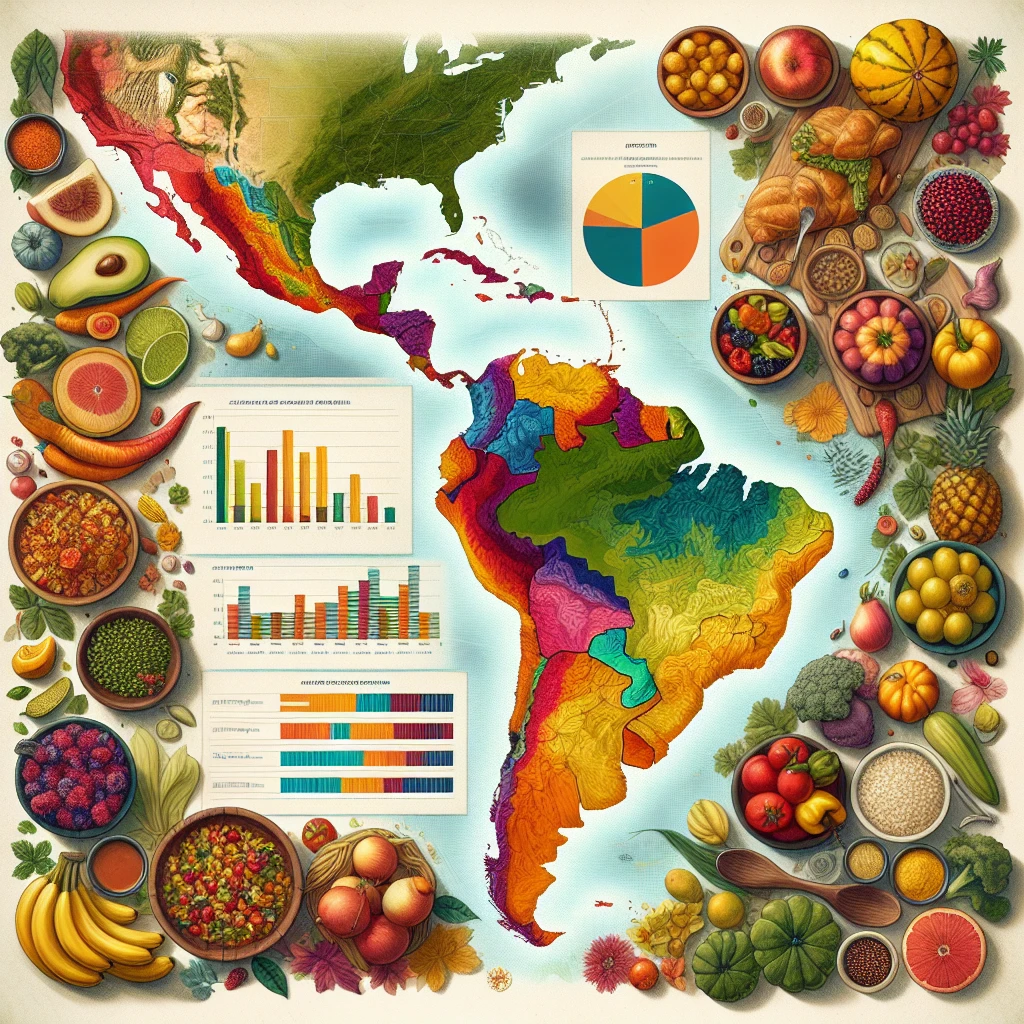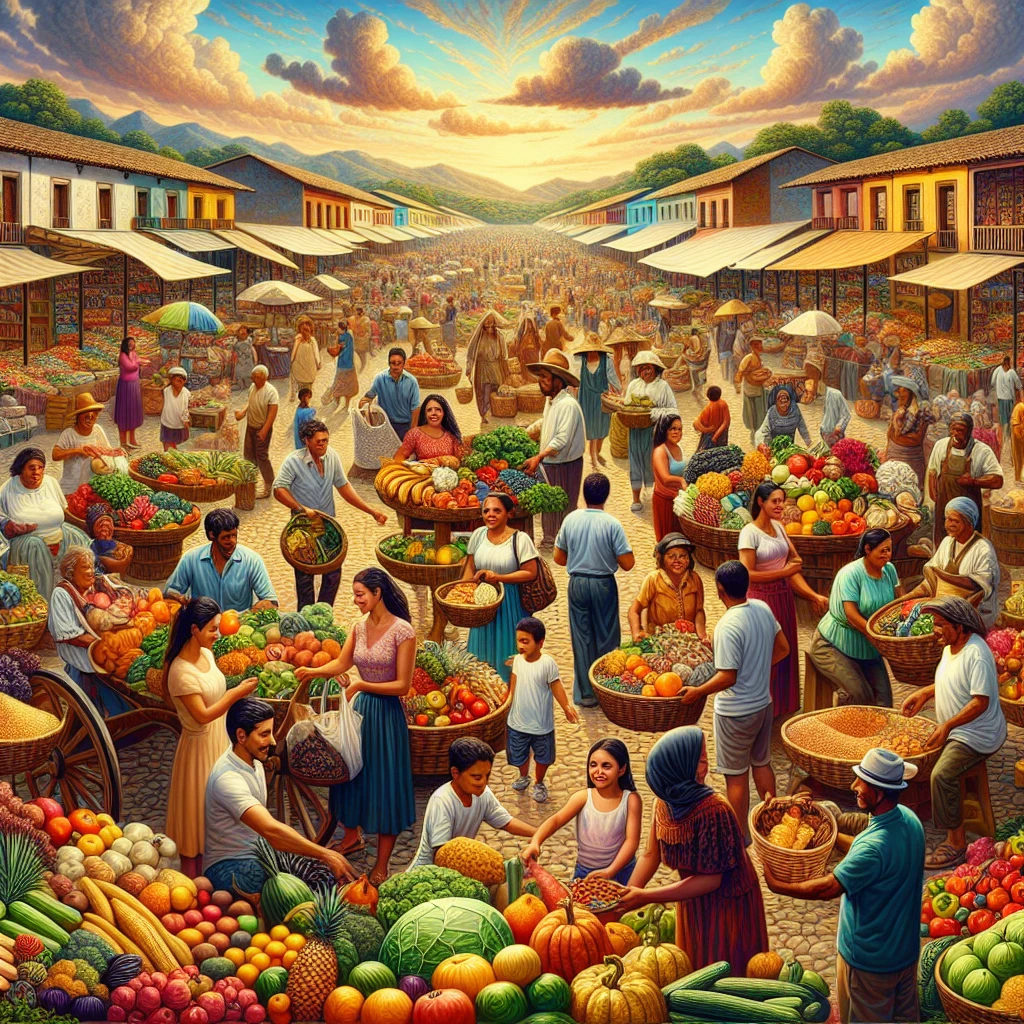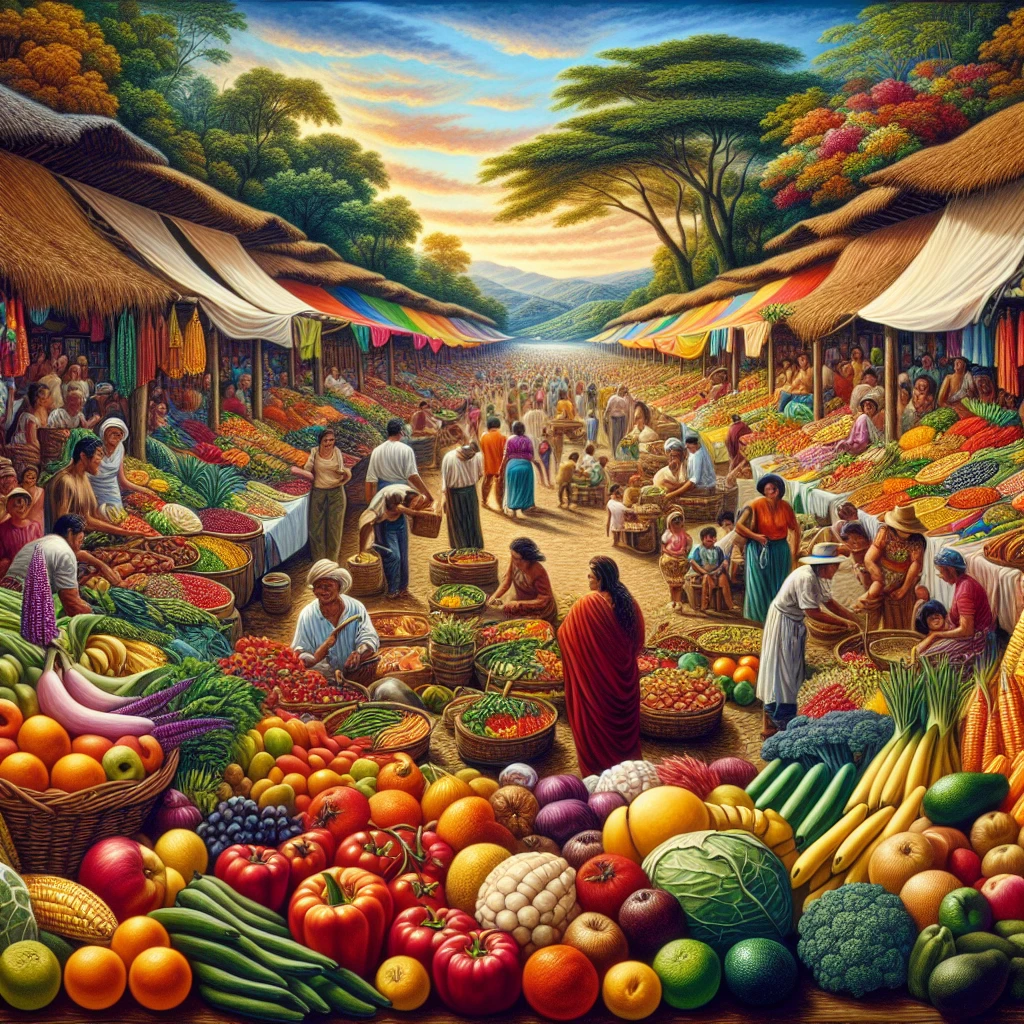

Food security refers to the availability, access, and utilization of safe and nutritious food for all. Nutrition, on the other hand, is the process of providing or obtaining the food necessary for health and growth.
Addressing food security and nutrition in Latin America and the Caribbean is crucial due to the high prevalence of food insecurity and malnutrition in the region.
The region faces significant challenges related to the cost and affordability of healthy diets, which directly impacts food security and nutrition. This is evident in the fact that a large proportion of the population in Latin America and the Caribbean cannot afford a healthy diet, leading to high levels of hunger and malnutrition.
As a result, it is essential to prioritize and focus on addressing these issues to ensure the well-being of the population in the region.
Furthermore, the socioeconomic state of the region, as well as national and regional data and trends, play a crucial role in understanding the complexities of food security and nutrition in Latin America and the Caribbean. By analyzing these factors, it becomes possible to identify the challenges and develop effective strategies to improve the affordability and accessibility of healthy diets, ultimately promoting better food security and nutrition outcomes for the population.
Check out this Youtube video: “Regional Overview of Food Security and Nutrition in Latin America and the Caribbean” to gain valuable insights into the current state of food security and nutrition in the region.
Current State of Food Security and Nutrition in Latin America and the Caribbean
Overview of food insecurity in the region
In 2020, 59.7 million people in the Latin America and Caribbean region suffered from hunger, marking a significant increase from the previous year. The prevalence of moderate or severe food insecurity has been alarming, with a sharp rise in hunger, reaching its highest point since 2000. The statistics reveal a bleak scenario for the future, indicating an urgent need for measures to address food insecurity in the region.
Impact of food insecurity on health and well-being
Food insecurity has been closely linked to adverse health outcomes, including chronic conditions such as obesity, heart disease, and diabetes. It poses a significant risk to mental health as well, leading to increased stress, depression, and anxiety, particularly among women.
The lack of access to affordable, nutritious food has been associated with detrimental effects on overall well-being, highlighting the critical intersection between food security and health outcomes.
Factors contributing to food insecurity and malnutrition in the region
The economic deficiencies experienced by the population of Latin America and the Caribbean, including unemployment, reduced income, and high food costs, are among the primary factors contributing to food insecurity. Additionally, the prevalence of malnutrition, encompassing both underweight and stunting, as well as overweight and obesity, underscores the complex and multifaceted nature of the challenges.
These issues demand a holistic approach that addresses the underlying economic, social, and nutritional determinants of food insecurity in the region.
| Category | Statistics |
|---|---|
| Hunger in 2020 | 59.7 million people |
| Prevalence of food insecurity | Highest since 2000 |
| Impact on health | Obesity, heart disease, mental health disorders |
| Contributing factors | Economic deficiencies, malnutrition |
The statistics and trends paint a worrying picture of the current state of food security and nutrition in Latin America and the Caribbean, necessitating concerted efforts to address these pressing challenges.
Government Initiatives and Policies
Efforts to address food security and nutrition at the national level
“National governments in Latin America and the Caribbean have implemented various initiatives to address food security and nutrition. For instance, in Brazil, the government launched the National School Feeding Program, which aims to provide healthy meals to school children, thereby addressing malnutrition at an early age.
Similarly, in Mexico, the government introduced the National Crusade Against Hunger, focusing on eradicating food insecurity through targeted interventions and support for vulnerable populations.”
Implementation of programs and projects aimed at improving access to food
“Numerous programs and projects have been implemented to improve access to food in the region. For example, Colombia’s government has undertaken the ‘Food and Nutrition Security Strategy’ to ensure access to food for all citizens, especially those in rural and marginalized areas.
Additionally, Peru has initiated the ‘Qali Warma’ program, offering nutritious meals to schoolchildren and creating economic opportunities for small-scale local food producers.”
Collaboration with international organizations to combat food insecurity
“To combat food insecurity, countries in Latin America and the Caribbean have engaged in collaborative efforts with international organizations. The Caribbean Regional Fisheries Mechanism (CRFM) has partnered with the Food and Agriculture Organization (FAO) to promote sustainable fisheries and aquaculture, ensuring a stable supply of protein-rich food.
Similarly, the Inter-American Development Bank (IDB) has collaborated with various countries in the region to fund projects focused on improving agricultural productivity and food distribution systems.”
| Country | Initiative | Impact |
|---|---|---|
| Brazil | National School Feeding Program | Addresses malnutrition in school children |
| Mexico | National Crusade Against Hunger | Targets food insecurity among vulnerable populations |
| Colombia | Food and Nutrition Security Strategy | Ensures access to food for citizens, especially in rural areas |
| Peru | Qali Warma program | Provides nutritious meals to schoolchildren and supports local food producers |
| Caribbean | CRFM partnership with FAO | Promotes sustainable fisheries and aquaculture |
| Latin America | IDB collaboration for agricultural productivity | Funds projects to improve food distribution systems |
These initiatives and collaborations demonstrate a concerted effort towards ensuring food security and nutrition in Latin America and the Caribbean, showcasing the magnitude of commitment from both national and international entities.
Regional Cooperation and Partnerships
Role of regional organizations in addressing food security and nutrition
Regional organizations play a crucial role in addressing food security and nutrition in Latin America and the Caribbean by facilitating collaboration and resource-sharing among member countries. For instance, the Inter-American Institute for Cooperation on Agriculture (IICA) has been instrumental in implementing sustainable agricultural practices and fostering knowledge exchange to enhance food production and nutrition.
Additionally, the Caribbean Community (CARICOM) has been at the forefront of developing region-specific strategies to combat malnutrition and ensure food security.
Collaborative efforts between countries in the region to address common challenges
Collaborative efforts between countries in the Latin America and Caribbean region have been pivotal in addressing common challenges related to food security and nutrition. For example, joint initiatives focusing on sustainable farming practices, food distribution networks, and research on climate-resilient crops have been established to combat shared food security challenges.
This collaborative approach has enabled countries to leverage their strengths and resources, leading to innovative solutions that benefit the entire region.
Impact of regional cooperation on improving food security and nutrition
The impact of regional cooperation on improving food security and nutrition in Latin America and the Caribbean has been profound. Through joint action plans and knowledge sharing, countries have seen improvements in agricultural productivity, accessibility to nutritious food, and resilience to environmental factors.
For instance, initiatives such as the Regional Fund for Agricultural Technology and Food Security have significantly enhanced the region’s capacity to address and mitigate food security vulnerabilities, leading to better nutrition outcomes for local populations.
Trends in Agriculture and Food Production
Adoption of sustainable agricultural practices
Sustainable agriculture practices, such as crop rotation and organic farming, play a crucial role in preserving the environment and ensuring long-term food security. For instance, the adoption of agroforestry in Latin America and the Caribbean has helped farmers maintain soil fertility and enhance biodiversity while improving food production.
Impact of climate change on food production in the region
The impact of climate change on food production in Latin America and the Caribbean is substantial, with extreme weather events and shifts in temperature and rainfall patterns posing significant challenges. For example, prolonged droughts in the region have adversely affected crop yields and livestock productivity, leading to food insecurity for many communities.
Role of technology and innovation in improving food security
In the context of Latin America and the Caribbean, technology and innovation are instrumental in bolstering food security. Precision agriculture, including the use of drones for crop monitoring and advanced irrigation systems, has contributed to improved yields.
Additionally, the integration of biotechnology in crop breeding has facilitated the development of resilient varieties capable of withstanding adverse climate conditions.
Nutritional Challenges and Public Health Interventions
Prevalence of malnutrition and obesity in Latin America and the Caribbean
The region of Latin America and the Caribbean faces significant challenges in terms of malnutrition and obesity. According to a new UN report, an alarming 43.2 million people in the region suffer from hunger, with 106 million adults grappling with obesity.
The prevalence of overweight in the region stands at 7.5%, exceeding the global average of 5.7%. These statistics highlight the pressing issues of malnutrition and obesity, posing serious health risks to the population.
Public health initiatives to combat malnutrition and promote healthy eating habits
Public health initiatives are being implemented to combat malnutrition and foster healthy eating habits in Latin America and the Caribbean. These initiatives emphasize the importance of primary healthcare, promoting breastfeeding, and creating environments conducive to healthy eating and physical activity, especially in schools.
Additionally, policymakers are focusing on strategies such as mandates, restrictions, economic incentives, and information provisions to accelerate progress in promoting healthier dietary habits among the population.
Challenges in ensuring access to nutritious foods for vulnerable populations
Despite efforts to address malnutrition and obesity, challenges persist in ensuring access to nutritious foods for vulnerable populations in Latin America and the Caribbean. High costs associated with a healthy diet, which increased by 5.3% in 2021, contribute to food insecurity in the region.
The United Nations report highlights that a substantial portion of the population, including 22.5% overall and 52% in the Caribbean, cannot afford a nutritious diet, indicating the magnitude of the accessibility challenge.
Gender and Food Security
The gender disparities in access to food and nutrition are a critical issue that demands attention. In many parts of Latin America and the Caribbean, women often face limited access to nutritious food due to prevailing gender inequalities.
These disparities manifest in various forms, such as unequal access to resources, limited decision-making power, and cultural norms that impact women’s ability to secure adequate nutrition. As a result, women are disproportionately affected by malnutrition and food insecurity, making it essential to address these disparities to ensure equal access to nutritious food for all.
The impact of gender inequality on food security and nutrition outcomes is significant, with women bearing the brunt of the consequences. Gender disparities not only affect women’s access to food but also impact their ability to make autonomous decisions about food consumption and dietary choices.
Furthermore, unequal access to education, employment opportunities, and healthcare further exacerbate the impact of gender inequality on food security and nutrition outcomes. As a result, women are more susceptible to malnutrition, which not only affects their individual well-being but also has broader implications for societal health and development.
Initiatives to address gender-based food insecurity and malnutrition are crucial for creating sustainable change. This involves implementing policies that aim to empower women, enhance their access to resources, and promote gender equality.
Additionally, community-based programs focusing on women’s education, financial inclusion, and healthcare can play a pivotal role in addressing the root causes of gender-based food insecurity. By fostering an environment that supports gender equality and provides women with the necessary tools and resources, it is possible to uplift communities and mitigate the impact of gender disparities on food security and nutrition.
| Gender Disparities | Impact of Gender Inequality | Initiatives to Address Gender-Based |
|---|---|---|
| Limited access to resources and | Disproportionate effect | Empowerment of women through |
| decision-making power for women | on women’s nutrition | policies and community programs |
| Unequal distribution of nutritious | Higher susceptibility to | Promoting education, financial |
| food resources based on gender | malnutrition and food | inclusion, and healthcare for women |
| Cultural norms impacting women’s | insecurity | |
| dietary choices |
Addressing gender disparities in access to food and nutrition, understanding the impact of gender inequality on food security and nutrition outcomes, and implementing initiatives to address gender-based food insecurity and malnutrition are essential steps towards fostering a more equitable and food-secure society in Latin America and the Caribbean.
Indigenous and Rural Communities
Unique challenges faced by indigenous and rural communities in accessing food
Indigenous and rural communities face unique challenges in accessing food due to various barriers. These include limited access to hunting and fishing grounds, discriminatory farm-lending practices, and environmental degradation.
Additionally, transportation issues and the higher cost of food in Tribal areas further exacerbate the difficulty in obtaining healthy and nutritious food. Lack of employment opportunities and low wages in rural areas also contribute to the struggle of affording food, making it a significant challenge for these communities.
Traditional food systems and their role in promoting food security and nutrition
For millennia, traditional food systems have been vital in promoting food security and nutrition in indigenous and rural communities. These systems encompass farming, fishing, and harvesting wild rice, providing nourishment and sustaining cultural diversity.
Consumption of traditional foods offers essential nutrients and dietary stability, helping mitigate disruptive dietary transitions and supporting agricultural resilience. Traditional food systems act as a cornerstone in maintaining the well-being, health, and intergenerational well-being of indigenous people.
The regeneration of biodiversity through traditional agricultural practices further enhances healthy ecosystems, contributing to long-term food security.
Efforts to improve food security for indigenous and rural populations
Initiatives aimed at improving food security for indigenous and rural populations have gained traction, focusing on the preservation and promotion of traditional food systems. Through an institutional resilience approach, unconventional strategies are being developed to mitigate food insecurity.
Projects and activities have been implemented to ensure the continuation of access to traditional food resources, emphasizing the importance of integrating traditional diets into daily life. Additionally, efforts such as increasing and stabilizing rural incomes, improving nutritional status, and forging sustainable, self-sufficient food systems are underway to address food insecurity in these communities.
The resilience and resourcefulness of indigenous communities play a crucial role in ensuring food security for present and future generations.
| Solution | Description |
|---|---|
| Traditional Diets | Incorporating traditional foods into daily consumption to bolster nutritional security and mitigate dietary transitions. |
| Sustainable Farming | Promoting sustainable agricultural practices to regenerate biodiversity, support healthy ecosystems, and ensure long-term food security. |
| Community Initiatives | Engaging in projects and activities to preserve and promote traditional food systems, reinforcing the resilience of indigenous communities. |
Urbanization and Food Security
Impact of urbanization on food access and availability
Urbanization has significantly impacted food access and availability in Latin America and the Caribbean. As more people migrate to urban areas, there is a heightened demand for food, leading to changes in food distribution and consumption patterns.
This drastic shift has created challenges in maintaining consistent and reliable food supplies, as urban areas struggle to keep up with the rising demand. Additionally, the limited space in urban settings poses challenges for local food production, resulting in a heavier reliance on imported goods.
The increased distance between food production and urban centers has also contributed to higher transportation costs, ultimately impacting the availability and affordability of food.
Challenges faced by urban populations in obtaining nutritious and affordable food
Urban populations in Latin America and the Caribbean face significant hurdles in obtaining nutritious and affordable food. One of the major challenges is the limited access to fresh and healthy produce, as urban areas are often saturated with convenience stores and fast-food outlets, offering less healthy options.
Furthermore, the cost of healthy food in urban areas tends to be higher compared to processed and less nutritious alternatives. This disparity in food pricing results in many urban residents opting for cheaper, less healthy options, impacting their overall nutrition and well-being.
Urban planning and food policy initiatives to address urban food insecurity
To combat urban food insecurity, proactive urban planning and robust food policy initiatives are essential. Implementing zoning regulations that encourage urban agriculture and community gardens can significantly improve the availability of fresh produce within urban areas.
Additionally, incentivizing grocery stores to offer a wider range of nutritious foods at competitive prices can alleviate the burden of high food costs for urban residents. Moreover, fostering partnerships between local governments and food providers can lead to the establishment of food distribution programs, ensuring consistent access to affordable and nutritious food for urban communities.
| Strategies to Address Urban Food Insecurity |
|---|
| 1. Zoning regulations promoting urban agriculture |
| 2. Incentivizing grocery stores to offer nutritious options |
| 3. Establishing food distribution programs in collaboration with local governments and food providers |
Urbanization’s impact on food availability presents a complex challenge in the Latin America and Caribbean regions, demanding innovative solutions and collaborative efforts to ensure access to nutritious and affordable food for urban populations.
Economic Factors and Food Security
The link between poverty, income inequality, and food insecurity is undeniable. As poverty and income inequality increase, so does the risk of food insecurity.
It’s a vicious cycle, where those with lower incomes struggle to access sufficient and nutritious food, leading to adverse health outcomes and perpetuating the cycle of poverty.
Economic policies play a critical role in shaping food security and nutrition outcomes. Policies that focus on poverty alleviation, income support, and employment opportunities can significantly impact the ability of individuals and families to access nutritious food.
For example, targeted social welfare programs and minimum wage regulations can uplift vulnerable populations and improve their food security.
Efforts to promote economic empowerment and food security for vulnerable populations are essential for breaking the cycle of poverty and food insecurity. Providing access to education, skill-building opportunities, and microfinance initiatives can empower individuals to secure better livelihoods and improve their access to food.
Additionally, community-based initiatives and support networks play a vital role in promoting economic empowerment and food security.
| Poverty Alleviation Policies | Impact on Food Security |
|---|---|
| Social welfare programs | Uplift vulnerable populations |
| Minimum wage regulations | Improve access to nutritious food |
Addressing economic factors is crucial in tackling food insecurity and malnutrition in Latin America and the Caribbean. By targeting poverty, income inequality, and promoting economic empowerment, sustainable progress towards food security can be achieved.
Food Trade and Globalization
Role of international trade in shaping food security outcomes
In the context of Latin America and the Caribbean, international trade plays a crucial role in shaping food security outcomes. Importing essential food items from other regions helps to supplement local production and mitigate the impact of crop failures and natural disasters.
For example, during periods of low coffee production in the region, the import of coffee from other countries ensures a steady supply for local consumption and export.
Impact of global market dynamics on food availability and access in the region
The global market dynamics significantly impact food availability and access in Latin America and the Caribbean. Fluctuating commodity prices in the international market directly influence the cost of imported food products, thereby affecting the overall affordability and accessibility for the local population.
For instance, a surge in global wheat prices can lead to higher bread prices in the region, impacting the accessibility of this staple food.
Policies and regulations related to food trade and their implications for food security
Policies and regulations governing food trade have substantial implications for food security in Latin America and the Caribbean. For example, the imposition of export restrictions on staple food items by certain countries can lead to a reduction in the global supply, thereby driving up prices and affecting food security in the region.
Additionally, trade agreements between countries can influence the flow of food products, impacting the diversity and availability of food items in local markets.
| Implications | Description |
|---|---|
| Export Restrictions | Decrease global food supply, leading to potential price increases and shortages. |
| Trade Agreements | Influence the availability and diversity of food products in local markets. |
Food Waste and Loss
Magnitude of food waste and loss in the region
The magnitude of food waste and loss in Latin America and the Caribbean region is staggering. According to the Environmental Protection Agency, in 2019, a staggering 66 million tons of wasted food were generated in the food retail, food service, and residential sectors alone.
This colossal figure paints a dire picture of the rampant wastage prevalent in the region, highlighting the urgent need for intervention.
Environmental and social consequences of food waste
The environmental and social consequences of food waste are nothing short of catastrophic. When we waste food, we also waste all the energy and water it takes to grow, harvest, transport, and package it.
Furthermore, wasted food accounts for one-third of all human-caused greenhouse gas emissions and generates 8% of greenhouse gases annually. This not only leads to severe environmental degradation but also has a profound impact on society at large.
Interventions to reduce food waste and improve food security
Efforts to reduce food waste and improve food security are crucial. Implementing state and local policies that encourage behaviors preventing food waste is a compelling intervention.
Additionally, focusing on reengineering production processes and improving training to reduce technical malfunctions and errors during processing are effective strategies. Furthermore, the United States has set a goal to reduce food loss and waste by 50% by the year 2030, emphasizing the global importance of this matter.
| Strategies for Intervention | Effectiveness |
|---|---|
| State and local policies encouraging behaviors preventing food waste | Highly effective |
| Reengineering production processes and improving training | Proven to be impactful |
| US goal to reduce food loss and waste by 50% by 2030 | Crucial for global impact |
Addressing the magnitude of food waste and loss in the Latin America and the Caribbean region is of utmost importance, considering its far-reaching environmental and social consequences. Interventions aimed at reducing food waste and improving food security are not only necessary but also pivotal for a sustainable and secure future for the region.
Key Challenges and Opportunities
Identification of major challenges in achieving food security and nutrition goals
The major challenges in achieving food security and nutrition goals in Latin America and the Caribbean revolve around access to nutritious food, especially for vulnerable populations. Additionally, the region faces issues with sustainable agricultural practices and climate change, impacting food production and availability.
Opportunities for collaboration and innovation to address food security challenges
There are opportunities for collaboration and innovation to address food security challenges in Latin America and the Caribbean. By promoting sustainable farming techniques, investing in food distribution infrastructure, and fostering partnerships between governmental and non-governmental organizations, the region can make significant strides in ensuring food security.
Role of public-private partnerships in addressing food security and nutrition
Public-private partnerships play a crucial role in addressing food security and nutrition in Latin America and the Caribbean. Through such partnerships, innovative solutions can be implemented to improve access to nutritious food, increase agricultural productivity, and offer support for vulnerable communities.
These collaborations also facilitate the sharing of expertise and resources to tackle the complex challenges related to food security in the region.
| Major Challenges | Opportunities for Collaboration | Role of Public-Private Partnerships |
|---|---|---|
| Access to Nutritious Food | Sustainable Farming Techniques | Innovative Solutions Implementation |
| Sustainable Agriculture | Investment in Food Distribution | Increased Agricultural Productivity |
| Climate Change Impacts | Government-NGO Partnerships | Support for Vulnerable Communities |
Latin America and the Caribbean face challenges related to access to nutritious food, sustainable agriculture, and climate change. However, through collaboration, innovation, and the involvement of public-private partnerships, these challenges can be effectively addressed, leading to improved food security and nutrition in the region.
Your actual response should be written all in this language: English (USA)
Role of Civil Society and Non-Governmental Organizations
Contribution of civil society organizations in addressing food security and nutrition
Civil society organizations play a crucial role in addressing food security and nutrition by advocating for policies that prioritize access to healthy and nutritious food for all community members. These organizations actively engage in community mobilization to ensure that nutrition programs are inclusive and impactful.
For example, organizations like The Hunger Project and Gapminder work in diverse regions, such as Asia, Africa, and South America, to mobilize communities and promote sustainable progress in nutrition. Their efforts have led to increased awareness and action towards achieving food security.
Initiatives and advocacy efforts to promote food security and nutrition
Civil society organizations have been at the forefront of initiating and advocating for efforts to promote food security and nutrition. Their initiatives range from grassroots projects to influencing global policies.
The World Food Programme (WFP) collaborates with around 1,000 non-governmental organizations (NGOs) worldwide, demonstrating the collective effort to bring much-needed assistance to millions of people across 120 countries. These initiatives not only provide immediate assistance but also work towards creating long-term sustainable solutions to food security challenges.
Collaboration between government and non-governmental organizations in addressing food security
The collaboration between governments and non-governmental organizations is vital in addressing food security comprehensively. By working together, they can provide the food industry with guidance, incentives, and support to align its practices with the public interest and global agendas.
This collaboration fosters trust, dialogue, and accountability among different sectors, leading to more effective and impactful measures towards achieving food security. These partnerships are essential for coordinated activities and programs between governments and NGOs, aiming to establish a framework that ensures the best outcomes for addressing food insecurity.
| Organization | Region | Focus |
|---|---|---|
| The Hunger Project | Asia, Africa, South America | Mobilizing rural communities for sustainable progress in nutrition |
| World Food Programme (WFP) | Global | Collaborating with 1,000+ NGOs for assistance in 120 countries |
| Gapminder | Global | Promoting sustainable global development and achievement of United Nations Millennium Development Goals |
Remember, we’re making food security great again!
Case Studies and Best Practices
Successful initiatives and programs in improving food security and nutrition in the region
One successful initiative is the FAO’s Regional Initiative for Latin America and the Caribbean, which focuses on improving the creation and implementation of multisectoral public policies and programs for food security. This initiative works directly with countries in the region to enhance their efforts in addressing food security and nutrition challenges.
Lessons learned from effective interventions in addressing food insecurity
Several lessons have been learned from effective interventions in addressing food insecurity. One key lesson is the importance of achieving effective territorial management of interventions for the reduction of extreme poverty and food insecurity.
Additionally, the integration of laws on food and nutrition security, as demonstrated by the Law No. in certain countries, has shown positive outcomes in combating food insecurity.
Best practices that can be replicated in other countries in Latin America and the Caribbean
Best practices that can be replicated in other countries in Latin America and the Caribbean include developing pilot interventions to address food insecurity, as seen in the significant scale-up of antiretroviral therapy (ART) to combat food insecurity’s barrier to ART utilization and adherence among certain demographics in the region. Additionally, addressing food insecurity in both rural and urban areas by enhancing access to assets and income generation has proven to be effective in combatting food insecurity.
| Key Points | Description |
|---|---|
| Successful initiatives | FAO’s Regional Initiative focuses on improving public policies and programs for food security in Latin America and the Caribbean. |
| Lessons learned | Effective interventions have highlighted the importance of territorial management and the integration of laws on food and nutrition security to combat food insecurity. |
| Best practices | Developing pilot interventions and addressing food insecurity in both rural and urban areas have proven to be effective practices that can be replicated in other countries in the region. |
Remember to keep the content engaging with a hint of humour and use ultra-specific details to captivate the audience!
Data and Statistics
Key data and statistics on food security and nutrition in Latin America and the Caribbean
As per the recent United Nations report on Food Security and Nutrition, it has been observed that 22.5% of the Latin America and the Caribbean population cannot afford a healthy diet. The data further reveals that in the Caribbean, the figure reaches a staggering 52%, while in Mesoamerica it stands at 27.8%, and in South America, it is at 18.4%.
Trends in food insecurity, malnutrition, and related health outcomes
The statistics displayed in the report depict a concerning trend in the region. In 2020, an alarming 59.7 million people in Latin America and the Caribbean suffered from hunger.
Additionally, the prevalence of hunger in the region witnessed an increase between 2019 and 2020, raising significant concerns about food insecurity and malnutrition.
Use of data for policy-making and program development
The data presented in the report serves as a critical foundation for policy-making and program development. These statistics provide essential insights into the extent of food insecurity and malnutrition in the region, enabling policymakers and program developers to devise targeted interventions and initiatives to address these pressing issues effectively.
| Region | Population Suffering Hunger |
|---|---|
| Caribbean | 52% |
| Mesoamerica | 27.8% |
| South America | 18.4% |
The data clearly highlights the severity of the situation and emphasizes the urgent need for collaborative efforts to combat food insecurity and malnutrition in Latin America and the Caribbean.
Recommended Amazon Products for Ensuring Access to Nutritious Foods in Latin America and the Caribbean
Here’s a curated list of products that can help improve access to nutritious foods in Latin America and the Caribbean. These recommendations are based on affordability, nutritional value, and product reviews.
- Nutribullet High-Speed Blender/Mixer System – This powerful blender is perfect for making nutritious smoothies with fresh fruits and vegetables, which are essential for a healthy diet. The Nutribullet is highly rated for its quality and performance.
- Instant Pot Duo 7-in-1 Electric Pressure Cooker – The Instant Pot is a versatile kitchen appliance that can cook nutritious meals quickly and easily. It offers various cooking functions and is well-reviewed for its convenience and efficiency.
- Freshware Meal Prep Containers – These reusable food storage containers are perfect for storing and portioning nutritious meals. They are microwave and dishwasher safe, making meal prep a breeze. Freshware containers are highly rated for their durability and practicality.
Pros and Cons of Recommended Products
| Product | Pros | Cons |
|---|---|---|
| Nutribullet Blender | – Power and performance- Ease of use- High customer satisfaction | – Relatively high price- Limited capacity for large batches |
| Instant Pot Pressure Cooker | – Versatility in cooking functions- Time-saving meal preparation- Positive customer feedback | – Learning curve for beginners- Higher initial cost |
| Freshware Containers | – Reusability and dishwashability- Practical for meal prep- Positive customer reviews | – Limited sizes for portioning- Durability concerns |
Top Recommended Product for Ensuring Access to Nutritious Foods in Latin America and the Caribbean
If you’re looking for the best solution for ensuring access to nutritious foods in Latin America and the Caribbean, we highly recommend the Nutribullet High-Speed Blender/Mixer System. Here’s why:
The Nutribullet High-Speed Blender/Mixer System is a top-rated product for its power and performance in creating nutritious smoothies from fresh ingredients. Its ease of use and high customer satisfaction make it the best choice for improving access to nutritious foods. Ready to improve your access to nutritious foods? Check out the Nutribullet today for the best results!


Conclusion
We have observed the significant progress made in addressing food security and nutrition in Latin America and the Caribbean. Efforts to promote sustainable agriculture, improve access to nutritious food, and enhance policy frameworks have contributed to positive outcomes in the region.
Furthermore, the collaboration among governments, organizations, and communities has played a crucial role in advancing food security and nutrition initiatives. The continued commitment to address the root causes of hunger and malnutrition has resulted in improved well-being and livelihoods for many individuals in Latin America and the Caribbean.
While challenges persist, the regional overview of food security and nutrition in Latin America and the Caribbean reflects promising advancements and a concerted effort to create a more sustainable and equitable food system for the future. The initiatives undertaken serve as a valuable foundation for further progress in ensuring access to nutritious food and improving overall health outcomes in the region.

















